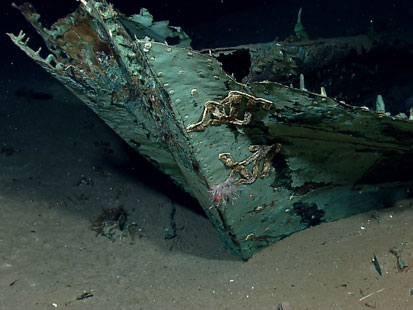200-Year-Old Shipwreck Discovered in Gulf of Mexico

Image credit: NOAA Okeanos Explorer Program
Scientists have discovered a 19th century shipwreck off the coast of the Gulf of Mexico. They made the find during an expedition led by the National Oceanic and Atmospheric Administration and the Bureau of Ocean Energy Management.
Researchers, working from the NOAA ship Okeanos Explorer, found remnants of a wooden-hulled vessel that is believed to be about 200 years old.
Using underwater robots and high definition cameras, scientists found a wealth of artifacts, including anchors, navigation equipment, glass bottles, ceramic plates, an iron stove, cannons and a box of muskets.
"This discovery was part of a larger mission to look at unknown or poorly-known areas in the Gulf of Mexico," said Frank Cantelas, a maritime archaeologist with NOAA's Office of Ocean Exploration and Research.
According to NOAA, "the 56-day expedition that ended April 29 was exploring poorly known regions of the Gulf, mapping and imaging unknown or little-known features and habitats, developing and testing a method to measure the rate that gas rises from naturally-occurring seeps on the seafloor, and investigating potential shipwreck sites."
Using sonar technology, researchers had a first look last fall at turned out to be the site of the shipwreck.
According to Cantelas, Shell Oil Company was conducting an oil and gas survey required by the government to be sure none of its projects are disturbing anything sensitive in the ocean.
"The site is in over 4,000 feet of water and we knew nothing about it - we just had a fuzzy image from a sonar recording, which is like a camera but uses sound instead of light," Cantelas said. "But we wanted to see what it was because it was shaped like it could be a shipwreck."
So NOAA partnered with the Bureau of Ocean Energy Management (BOEM), which issues permits for bottom-disturbing activities related to oil and gas exploration, to find the 200-year-old shipwreck.
The ship used telepresence technology to transmit what was happening on the ship live.
"Telepresence provides the ability to bring a lot of different specialists, who have various expertise, to the table during the dive," said Fred Gorell, public affairs officer for NOAA's office of Exploration and Research. "They could actually look at the wreck sites while it was happening. And this way research is not limited by the number of people who are actually on the ship."
"Artifacts in and around the wreck and the hull's copper sheathing may date the vessel to the early to mid-19th century," said Jack Irion, a maritime archaeologist with BOEM, in a NOAA statement. "Some of the more datable objects include what appears to be a type of ceramic plate that was popular between 1800 and 1830, and a wide variety of glass bottles. A rare ship's stove on the site is one of only a handful of surviving examples in the world and the second one found on a shipwreck in the Gulf of Mexico."
And researchers hope this discovery will help in other areas.
"Archaeologically, this is a very significant find," Cantelas said. "It appears to date back to the early 1800s and a lot was going on in the Gulf of Mexico around that time. You have the Louisiana Purchase, the Texas Revolution, the Mexican-American War - a lot of conflict in that region…So this research will hopefully help us fill in the blank pages of history. It will provide information hat we don't really know about the history of the Gulf region."